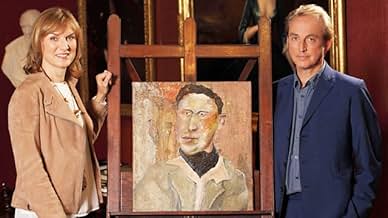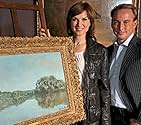La periodista Fiona Bruce forma equipo con el experto en arte Philip Mould para investigar los misterios que se esconden tras los cuadros.La periodista Fiona Bruce forma equipo con el experto en arte Philip Mould para investigar los misterios que se esconden tras los cuadros.La periodista Fiona Bruce forma equipo con el experto en arte Philip Mould para investigar los misterios que se esconden tras los cuadros.
Explorar episodios
Opiniones destacadas
An upmarket version of Flog It!, Dickinson's Real deal etc. Where fortunes can be decided upon by one person or a small group of experts. I am often puzzled when the decision by the expert(s) is "fake" when I'm convinced that it's "fortune", but what do I know, not a lot probably. The viewer's interest is kept going from the start to the big reveal at the finish.
Whether you like art or not this programme is fascinating. Love to see how they X-ray the paintings and analyse the paint to figure out if it's by the artist. So annoying when the verdict hangs on one person though!
This is a fantastic series investigating where artworks came from. Even my Dad is hooked and he's not usually into art. There are so many twists and turns from the back stories, historical and scientific research.
Every episode is like the best Columbo, Law and Order, and Perry Mason you have ever seen rolled into one. Deeply respect Fiona, Phillip, and Bendor's calm as they go through the ups and downs of each investigation...and we learn about the great works of art and the artists as they investigate. The bonus is...everything you see is real, no scripts.
One episode a masterpiece was found by a junkyard...another someone has had decades and tracking it trail of ownership or provenance is really quite fascinating...
Highly recommended.
One episode a masterpiece was found by a junkyard...another someone has had decades and tracking it trail of ownership or provenance is really quite fascinating...
Highly recommended.
In the book and later film "the Da Vinci Code", much of the opening scenes take place in the most prestigious art gallery in the world: The Louvre in Paris, France. From the Louvre in Paris, to the French countryside, to Westminster Abbey in London, fictional characters Robert Langdon and his female companion Sophie Neveu embark on a trail which combines religious and art history with an action-packed thriller. Take away the car chases and the assassinations, but add real-life works shrouded in both inspiration and mystery. Then add to the mix attractive detectives on the hunt to reveal the truth about important and valuable works of art, both modern and old-master, and you just might end up with "Fake or Fortune?".
The relatively recent BBC series involves three art historian-detectives who are on a never-ending quest to discover the truth about intriguing paintings which have crossed their paths, either by accident or design. The paintings being researched share a few things in common: they are not on display in a prestigious museum and/or they are in private hands. All of them share the distinction of not being attributed to a great master artist. Philip Mould is a real-life art historian and dealer, the series' equivalent of Robert Langdon. His career which spans a quarter-century before the series went on air involves hunting down lost art. At the beginning of his career he bought a painting at a humble auction for only £180 (about $275 US) before research revealed it was a 17th-century painting, later resold for £12,000 ($20,000 US).
Although the fictional character Sophie Neveu is a forensics detective, Fiona Bruce has some interesting similarities, having been an award-winning television journalist with the BBC and an appraiser on the UK version of the Antiques Roadshow. Her tasks on the show involve historical investigations, often discovering the contexts when a work in question was produced and later events which also impacts a work's provenance, i.e. its history. Lastly but not least is Bendor Grosvenor, who, like his colleague Mould, is interested in lost and mis-catalogued works of art. Grosvenor is often the one to find missing paintings in catalogs at auctions or other places where a masterpiece might be hidden. Sometimes he and Mould discover works for sale which are completely misattributed. He also researches provenance history and uses technology to demonstrate certain aspects of an artwork which under current investigation.
So far there have been about 10 episodes broken up into 3 series, with a 4th hopefully on the way. Among the highlights have been a painting thought to be a Rembrandt, once confiscated by the Nazis in the 1930's, a couple of paintings attributed to unknown artists which Mould believes could be by one of Britain's most important artists, Thomas Gainsborough, and some early 19th-century Turners stashed in the basement of an art gallery when experts from the 1950's believed they were misattributed. (Some sailing experts have refuted some of the series' conclusions stating the boats in the pictures may be in fact from the early 20th century, not the 19th.) My favorite thus far is a lost Van Dyck from the early 17th century possibly painted over in the 18th century. I won't reveal all the details of this episode but to say that this is one of the best finds by the three colleagues, and must have been a shock and surprise to the art world at large.
Overall, one of the most fascinating documentary shows of recent memory, which makes PBS' the History Detectives seem a little tame by comparison. If you like the Da Vinci Code, the Antiques Roadshow (both UK and US versions), and the History Detectives, you can't go wrong with "Fake or Fortune?" Excellent job, BBC. Please tell PBS to broadcast more episodes.
The relatively recent BBC series involves three art historian-detectives who are on a never-ending quest to discover the truth about intriguing paintings which have crossed their paths, either by accident or design. The paintings being researched share a few things in common: they are not on display in a prestigious museum and/or they are in private hands. All of them share the distinction of not being attributed to a great master artist. Philip Mould is a real-life art historian and dealer, the series' equivalent of Robert Langdon. His career which spans a quarter-century before the series went on air involves hunting down lost art. At the beginning of his career he bought a painting at a humble auction for only £180 (about $275 US) before research revealed it was a 17th-century painting, later resold for £12,000 ($20,000 US).
Although the fictional character Sophie Neveu is a forensics detective, Fiona Bruce has some interesting similarities, having been an award-winning television journalist with the BBC and an appraiser on the UK version of the Antiques Roadshow. Her tasks on the show involve historical investigations, often discovering the contexts when a work in question was produced and later events which also impacts a work's provenance, i.e. its history. Lastly but not least is Bendor Grosvenor, who, like his colleague Mould, is interested in lost and mis-catalogued works of art. Grosvenor is often the one to find missing paintings in catalogs at auctions or other places where a masterpiece might be hidden. Sometimes he and Mould discover works for sale which are completely misattributed. He also researches provenance history and uses technology to demonstrate certain aspects of an artwork which under current investigation.
So far there have been about 10 episodes broken up into 3 series, with a 4th hopefully on the way. Among the highlights have been a painting thought to be a Rembrandt, once confiscated by the Nazis in the 1930's, a couple of paintings attributed to unknown artists which Mould believes could be by one of Britain's most important artists, Thomas Gainsborough, and some early 19th-century Turners stashed in the basement of an art gallery when experts from the 1950's believed they were misattributed. (Some sailing experts have refuted some of the series' conclusions stating the boats in the pictures may be in fact from the early 20th century, not the 19th.) My favorite thus far is a lost Van Dyck from the early 17th century possibly painted over in the 18th century. I won't reveal all the details of this episode but to say that this is one of the best finds by the three colleagues, and must have been a shock and surprise to the art world at large.
Overall, one of the most fascinating documentary shows of recent memory, which makes PBS' the History Detectives seem a little tame by comparison. If you like the Da Vinci Code, the Antiques Roadshow (both UK and US versions), and the History Detectives, you can't go wrong with "Fake or Fortune?" Excellent job, BBC. Please tell PBS to broadcast more episodes.
¿Sabías que…?
- TriviaFiona Bruce and Philip Mould attempt to prove the provenance of works of art using experts, scientific methods and plain old detective work.
Selecciones populares
Inicia sesión para calificar y agrega a la lista de videos para obtener recomendaciones personalizadas
Detalles
- Fecha de lanzamiento
- País de origen
- Sitio oficial
- Idioma
- También se conoce como
- Fake or Fortune
- Productora
- Ver más créditos de la compañía en IMDbPro
- Tiempo de ejecución1 hora 3 minutos
- Color
Contribuir a esta página
Sugiere una edición o agrega el contenido que falta

Principales brechas de datos
By what name was Fake or Fortune? (2010) officially released in India in English?
Responda


















